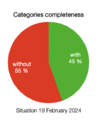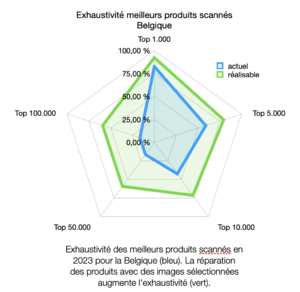Difference between revisions of "Product completeness"
(created) |
|||
| (8 intermediate revisions by the same user not shown) | |||
| Line 24: | Line 24: | ||
* [https://world.openfoodfacts.org/state/categories-completed categories completed] and [https://world.openfoodfacts.org/state/categories-to-be-completed categories to be completed]; | * [https://world.openfoodfacts.org/state/categories-completed categories completed] and [https://world.openfoodfacts.org/state/categories-to-be-completed categories to be completed]; | ||
| − | + | == Visualisation == | |
| + | The completeness can be visualised with a pie chart, either for each field or all fields combined. | ||
| + | [[File:WorldCompletenesscategories.png|100px|thumb|left]] These graphs can be made for individual countries as well. Depending on the impact of OFF in each country the completeness percentage is smaller or lower. The fraction combines all products even whether they are never looked at. | ||
| − | + | [[File:Completeness France.png|100px|thumb|right]]It is more useful to look at the completeness of products that are actually used. For 2023 it has been registered which products are scanned 1.000, 5.000 times, etc. It would be great to be able to provide complete information for these products. The distribution of the completeness for various scanned products is shown in the radar graph (blue line). | |
| − | + | == Improving completeness == | |
| + | Any completeness indicator involves a large number of products. Changing these numbers requires a lot of work as editing each product takes a lot of time. Furthermore does OFF have the information to complete a products. To complete a product, images of its packaging are needed. But even limiting edits to products that have images, there is still no guarantee that these are useful images. | ||
| + | |||
| + | It is possible to limit potential edits to products that have images assigned to ingredients and nutritional data. And then by starting to edit the most scanned products, it is possible to see progress, even if the overall completeness percentage does not change. | ||
| + | |||
| + | Thus in the radar graph it is possible any edit will move the blue line toward the green line. For a country like France with a lot of products, this still involved a lot of edits. For a country like Belgium the number of edits are much smaller and the effects more easily visible (graph below). | ||
| + | [[File:Completeness Belgium.png|300px|thumb|center|Completeness radar graph for Belgium (February 2024)]] | ||
Latest revision as of 16:28, 19 February 2024
One of the goals of Open Food Facts is the ability to enhance the information provided by producers on their product packaging (readability, understandability, enhancement). What Open Food Facts will be able to do depends on the information provided on the packaging. This information starts with minimally legally required information to full transparency on supply chain and production processes.
The information available on the packaging must be extracted to the OFF-database and be transcribed correctly. Having the correct information is assessed by various the data quality approaches (insert link here).
The main enhancement that OFF currently, as of 19 February 2024, performs are:
- Nutriscore calculation, which requires nutritional information and some categorisation;
- Ultraprocessing assessment (NOVA), which requires ingredients;
- Diet suitability assessment, which requires in ingredients, traces and labels;
- Environmental impact, which requires information categorisation, supply chain information and production processes (in the experimental phase);
When OFF is able to make all these assessments for a product, it means that all necessary information was available. The product information would have complete. Whether this will be the case depends a lot on the producer in providing this information (full transparency).
Completeness
OFF strives to have complete information, i.e. have all information available on the package. As providing some information is optional, the concept completeness is limited to legally required information. The non-optional information falls under the heading transparency.
The most important information fields that OFF wants to have are:
- ingredients
- nutritional values
- product category (limited)
The system tracks whether these fields are filled in, using these status:
- ingredients completed and ingredients to be completed;
- nutrition facts completed and nutrition facts to be completed;
- categories completed and categories to be completed;
Visualisation
The completeness can be visualised with a pie chart, either for each field or all fields combined.
These graphs can be made for individual countries as well. Depending on the impact of OFF in each country the completeness percentage is smaller or lower. The fraction combines all products even whether they are never looked at.
It is more useful to look at the completeness of products that are actually used. For 2023 it has been registered which products are scanned 1.000, 5.000 times, etc. It would be great to be able to provide complete information for these products. The distribution of the completeness for various scanned products is shown in the radar graph (blue line).
Improving completeness
Any completeness indicator involves a large number of products. Changing these numbers requires a lot of work as editing each product takes a lot of time. Furthermore does OFF have the information to complete a products. To complete a product, images of its packaging are needed. But even limiting edits to products that have images, there is still no guarantee that these are useful images.
It is possible to limit potential edits to products that have images assigned to ingredients and nutritional data. And then by starting to edit the most scanned products, it is possible to see progress, even if the overall completeness percentage does not change.
Thus in the radar graph it is possible any edit will move the blue line toward the green line. For a country like France with a lot of products, this still involved a lot of edits. For a country like Belgium the number of edits are much smaller and the effects more easily visible (graph below).


